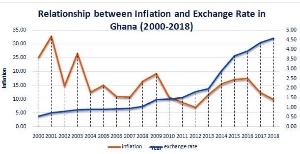Analysis of the performance of cedi against its major trading and intervention currency, the US dollar, has revealed that the local currency is still depreciating, steadily, as assessed in year-to-date terms.
As at June 29, data from the Bank of Ghana’s interbank exchange market revealed that the local currency recorded its worst half-year performance since 2015. Furthermore, by the close of trading activities on Friday, September 27, 2019, the cedi had depreciated further from its former position during the half year period.
The cedi has currently depreciated against the US dollar by 9.34 percent, year-to-date, as it was trading at GHc 5.32 to US$ 1 by the end of last week.
The sharp fall of the cedi during the early part of the year was cushioned when the central bank boosted it foreign reserves through the government issuance of a US$3 billion Eurobond as well as the enforcement of a number of forex directives.
Some analysts in the international treasury market insist that the central bank has been able to managed to Eurobond very well, which has led to a fairly stable forex market over the past few months, unlike the situation in the first quarter of the year.
Notwithstanding the steady decline of the cedi, the central bank is still seeking to hold further depreciation at bay, with the introduction of some measures, such as the yet to be implemented foreign exchange forward rate auction limited to 7-day, 15-day, 30-day, 45-day, 60-day and 75-day tenors on October 1, 2019.
The auction will allow banks, on behalf of their clients to lock into exchange rates now for delivery of forex later in the year.
This will expectedly curb the activities of currency speculators who otherwise would store up forex in the hope of selling it at significantly higher exchange rates towards the end of the year in order to make a tidy profit.
Business News of Monday, 30 September 2019
Source: goldstreetbusiness.com

















